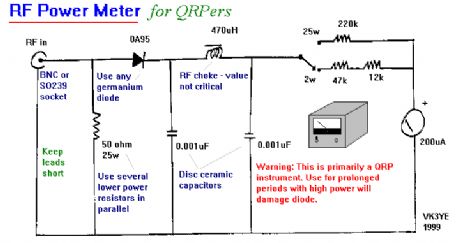
Circuit Diagram
Index 273
Simple FM Transmitter
Published:2012/11/15 0:58:00 Author:muriel | Keyword: Simple , FM , Transmitter
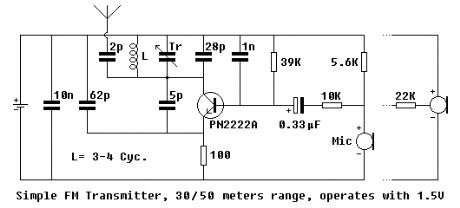
Simple FM transmitter with a single transistor. Mini FM transmitters take place as one of the standard circuit types in an amateur electronics fan's beginning steps. When done right, they provide very clear wireless sound transmission through an ordinary FM radio over a remarkable distance. I've seen lots of designs through the years, some of them were so simple, some of them were powerful, some of them were hard to build etc.
Here is the last step of this evolution, the most stable, smallest, problemless, and energy saving champion of this race. circuit given below will serve as a durable and versatile FM transmitter till you break or crush it's PCB. Frequency is determined by a parallel L-C resonance circuit and shifts very slow as battery drains out. Schematic Simple FM Transmitter involves on a single transistor oscillator Technical datas: Supply voltage : 1.1 - 3 Volts Power consumption : 1.8 mA at 1.5 Volts Range : 30 meters max. at 1.5 Volts Main advantage of this circuit is that power supply is a 1.5Volts cell (any size) which makes it possible to fix PCB and the battery into very tight places. Transmitter even runs with standard NiCd rechargeable cells, for example a 750mAh AA size battery runs it about 500 hours (while it drags 1.4mA at 1.24V) which equals to 20 days. This way circuit especially valuable in amateur spy operations :) Transistor is not a critical part of the circuit, but selecting a high frequency / low noise one contributes the sound quality and range of the transmitter. PN2222A, 2N2222A, BFxxx series, BC109B, C, and even well known BC238 runs perfect. Key to a well functioning, low consumption circuit is to use a high hFE / low Ceb (internal junction capacity) transistor. Not all of the condenser microphones are the same in electrical characteristics, so after operating the circuit, use a 10K variable resistance instead of the 5.6K, which supplies current to the internal amplifier of microphone, and adjust it to an optimum point where sound is best in amplitude and quality. Then note the value of the variable resistor and replace it with a fixed one. The critical part is the inductance L which should be handmade. Get an enameled copper wire of 0.5mm (AWG24) and round two loose loops having a diameter of 4-5mm. Wire size may vary as well. Rest of the work is much dependent on your level of knowledge and experience on inductances: Have an FM radio near the circuit and set frequency where is no reception. Apply power to the circuit and put a iron rod into the inductance loops to chance it's value. When you find the right point, adjust inductance's looseness and, if required, number of turns. Once it's OK, you may use trimmer capacitor to make further frequency adjustments. You may get help of a experienced person on this point. Do not forget to fix inductance by pouring some glue onto it against external forces. If the reception on the radio lost in a few meters range, than it's probably caused by a wrong coil adjustment and you are in fact listening to a harmonic of the transmitter instead of the center frequency. Place radio far away from the circuit and re-adjust. An oscilloscope would make it easier, if you know how to use it in this case. Unfortunately I don't have any :( Every part should fit on the following PCB easily. Pay attention to the transistor's leads which should be connected right. Also try to connect trimmer capacitor's moving part to the + side, which may help unwanted frequency shift while adjusting. PCB drawing should be printed at 300DPI, here is a TIFF file already set. The one below is a past PCB work of mine, which was prepared to fit into a pocket flashlight. Since it was so crowded, use the new computerized PCB artwork instead, yet very small. Take a look at my PCB design page to get information on my work style. Here is a completed and perfectly running circuit, mounted in a pocket light, taking the advantage of the 1.5V AA cell slot near it. Microphone is fixed into the bulb's place and antenna is made out of a 30cm soft cable. When cover is placed, it becomes very handy! Do not forget, restrictions on radio frequency transmitting devices may differ in your local area. This circuit has a power output that should be less than 1mW so have to be safe under many kinds of legal conditions but particular attempts such as listening to other people's private life will always be disapproved everywhere. (View)
View full Circuit Diagram | Comments | Reading(4324)
Sensitive FM Transmitter Bug
Published:2012/11/15 0:58:00 Author:muriel | Keyword: Sensitive, FM , Transmitter Bug
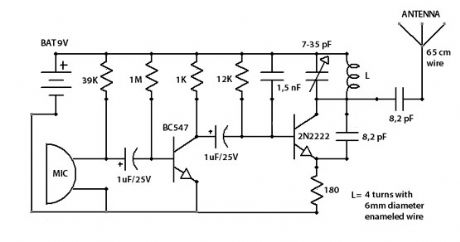
This easy to build FM transmitter bug can transmit voice to exceptionally good range. Tune trimmer to hear the signal to your near radio. Transmitter frequency range is 88-108 MHz. Max current consumption is 30mA. You can power the fm transmitter bug with a 9Volt Battery, or you can plug a power supply to feed in 9-12 Volts. That bug will pick even a low whisper or even the sound of a breath well far from the microphone. Great spy transmitter equipment. (View)
View full Circuit Diagram | Comments | Reading(1696)
SAA1057 PLL Synthesized FM Transmitter
Published:2012/11/15 0:56:00 Author:muriel | Keyword: SAA1057, PLL, Synthesized, FM , Transmitter
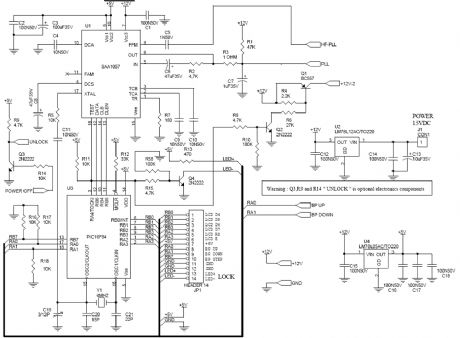
The functioning of all is provided by a microcontroller from MICROCHIP PIC16F84 which provides support for buttons, LCD 2 lines of 16 characters and the circuit pll SAA1057. The VCO is entrusted to the transistor Q8 associate of his two diodes varicaps BB109, a floor buffer Q7 separates the VHF signal obtained in two ways, on the one hand to Q9 to enslave loop phase and on the other hand to the Q5 and Q6 together which takes care to amplify the signal before attacking Q11, a BFR96 which plays the role of HF switch via a timer NE555 which receives information from the push and SAA1057 ensuring HF cutoff in the event of failure of a locking or unlocking of the pll. (View)
View full Circuit Diagram | Comments | Reading(4289)
RF Preamplifier
Published:2012/11/15 0:49:00 Author:muriel | Keyword: RF Preamplifier
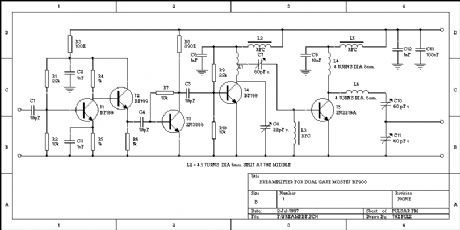
Input needs only several mWatts (e.g. BF900) -> 300 mWatts OUT. This schematic is a often used buffer. It's easy to build, clean and cheap. When you want even more power, you can replace the 2N2219a by a 2N4427 or 2N3553. You can lower the output by adding a little resistor (10..47 Ohm 1/2W) in the emitter line of the 2N2219a. (View)
View full Circuit Diagram | Comments | Reading(5803)
RF Power Meter
Published:2012/11/15 0:49:00 Author:muriel | Keyword: RF , Power Meter
View full Circuit Diagram | Comments | Reading(0)
RF Field Strength Meter with Attenuator up to 200 MHz
Published:2012/11/15 0:48:00 Author:muriel | Keyword: RF, Field Strength Meter , Attenuator, 200 MHz
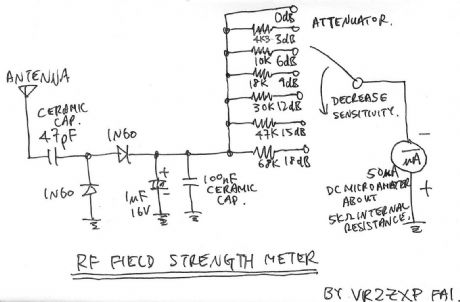
RF Field Strength Meter with Attenuator up to 200 MHz The RF field meter unit is a great help to tune transmitters for best performance and output power. You can measure the radiated energy field and can easy tune the system for max output field strength maximum power. This field strength meter comes with selectable attenuator. You can use it for measuring the antenna gain and pattern, compare different magnetic field strengths. See the following RF field strength meter schematic. (View)
View full Circuit Diagram | Comments | Reading(2097)
RF Field Strength Meter
Published:2012/11/15 0:47:00 Author:muriel | Keyword: RF , Field Strength Meter
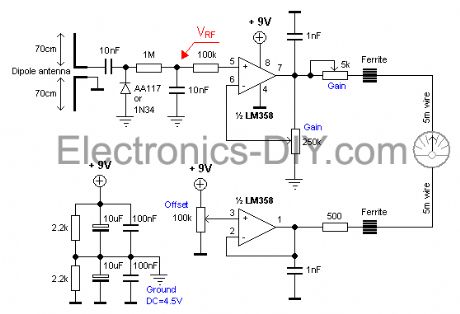
Most transmitter has several variable capacitors which are used to match impedance for transistors and antennas. I know people hate trimmers and so did I. The reason is that it is difficult to trim a system if you can't measure the performances. To trim a transmitter you need to measure the output power. Most transmitter are tuned with a dummy load of 50 ohm to substitute an antenna of 50 ohm. Not everyone has a power meter, and how can you know that the antenna you connect is purely 50 ohm. If not, the hole trimming is waste of time! What you would like to do is to measure the radiated power out from the antenna you actually are going to use. If you can measure the radiated energy field you can easy tune the system for max output field strength (max power). So, how can we measure the radiated energy field? The block diagram at right show you one easy way to measure the RF filed strength. To the left you find a dipole antenna. The antenna should be cut to match the receiving frequency ... (View)
View full Circuit Diagram | Comments | Reading(3582)
RF Buffer Stage
Published:2012/11/15 0:46:00 Author:muriel | Keyword: RF , Buffer Stage
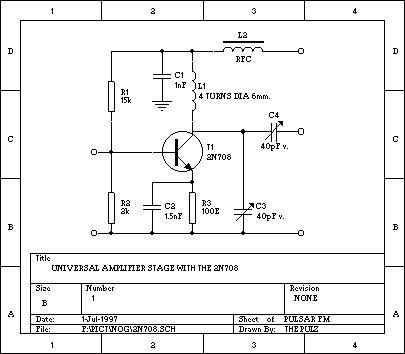
This bufferstage is intended to be used after a BF900 or BF199 (even a BF245) oscillator. It delivers several milliwatts and is perfect to drive a 2N2219 or 2N4427. Be sure the coils are really round and can see each other: place metalplates between the coils. The supply voltage is around 12V (typ. 13,8V). (View)
View full Circuit Diagram | Comments | Reading(3994)
Remote control using VHF modules
Published:2012/11/15 0:45:00 Author:muriel | Keyword: Remote control, VHF modules
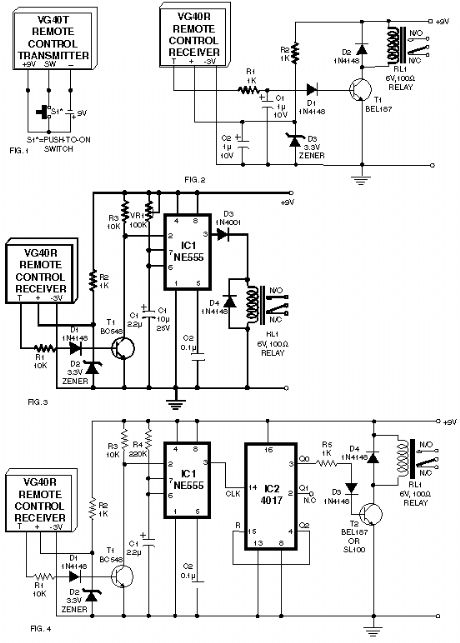
A few designs for remote control switches, using VG40T and VG40R remote control pair, are shown here. The miniature transmitter module shown in Fig. 1, which just measures 34 mm x 29 mm x 10 mm, can be used to operate all remote control receiver-cum-switch combinations described in this project. A compact 9-volt PP3 battery can be used with the transmitter. It can transmit signals up to 15 metres without any aerial. The operating frequency of the transmitter is 300 MHz. The following circuits, using VG40R remote control receiver module measuring 45 mm x 21 mm x 13 mm, can be used to: (a) activate a relay momentarily, (b) activate a relay for a preset period, (c) switch on and switch off a load. (View)
View full Circuit Diagram | Comments | Reading(1207)
Ramsey 25 BA1404 Stereo FM Transmitter
Published:2012/11/15 0:45:00 Author:muriel | Keyword: Ramsey , 25 , BA1404 , Stereo , FM, Transmitter
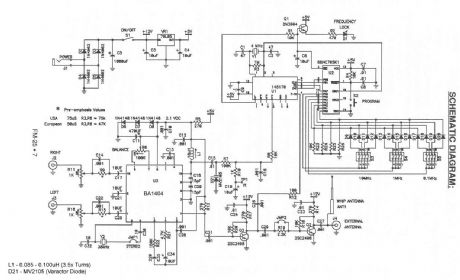
Stereo FM transmitter based on BA1404 and 145170 frequency synthesizer IC. (View)
View full Circuit Diagram | Comments | Reading(4482)
Radio Remote Control using DTMF
Published:2012/11/15 0:44:00 Author:muriel | Keyword: Radio, Remote Control , DTMF
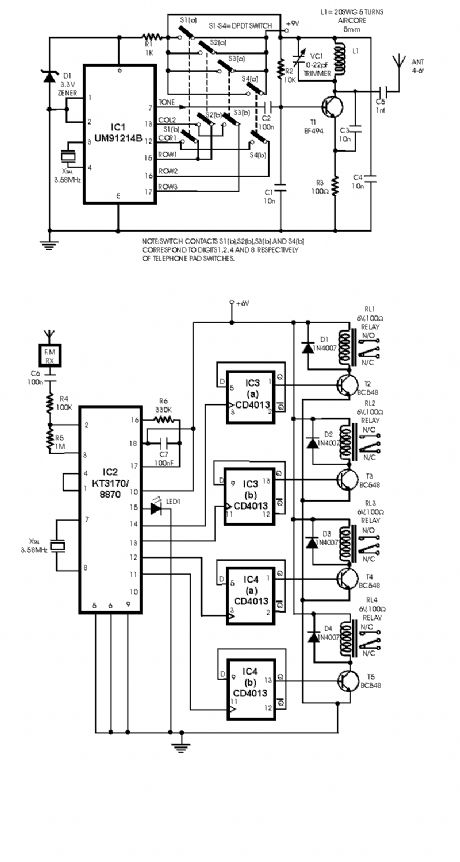
Here is a circuit of a remote control unit which makes use of the radio frequency signals to control various electrical appliances. This remote control unit has 4 channels which can be easily extended to 12. This circuit differs from similar circuits in view of its simplicity and a totally different concept of generating the control signals. Usually remote control circuits make use of infrared light to transmit control signals. Their use is thus limited to a very confined area and line-of-sight. However, this circuit makes use of radio frequency to transmit the control signals and hence it can be used for control from almost anywhere in the house.
Here we make use of DTMF (dual-tone multi frequency) signals (used in telephones to dial the digits) as the control codes. The DTMF tones are used for frequency modulation of the carrier. At the receiver unit, these frequency modulated signals are intercepted to obtain DTMF tones at the speaker terminals. This DTMF signal is connected to a DTMF-to-BCD converter whose BCD output is used to switch-on and switch-off various electrical appliances.
(View)
View full Circuit Diagram | Comments | Reading(1418)
Prescaler with Counter
Published:2012/11/15 0:43:00 Author:muriel | Keyword: Prescaler , Counter
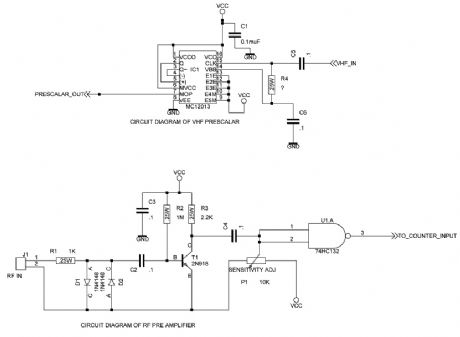
Digital frequency counter is being used for wide range of applications. Digital frequency counter extensively uses digital circuits and hence fairly good knowledge of digital circuits and of digital integrated circuits is required to understand the operation of the frequency counter. However a person who is not familiar with any electronics circuits and experiments has in written this article. (View)
View full Circuit Diagram | Comments | Reading(1463)
PLL Stereo FM Transmitter
Published:2012/11/15 0:41:00 Author:muriel | Keyword: PLL, Stereo , FM, Transmitter
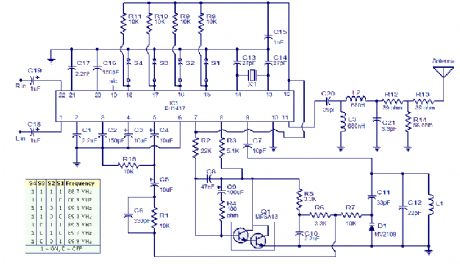
The circuit shown here is of a good Stereo FM transmitter that can transmit high quality signals up to a range of 70 feet. The circuit is based on BH1417 PLL stereo transmitter IC from Rhom semiconductors. The IC has separate audio processing sections for the left and right channels, pre emphasis circuit for improving signal to noise ratio, crystal control circuitry for accurate frequency locking, multiplex circuit for making sum ( left plus right) and difference ( left minus right) {see this article for better understanding Stereo decoder circuit} etc. Another important feature of this IC is that the transmission frequency can be set using a 4 channel DIP switch. The IC can be powered from anything between 4 to 6V DC and has an output power around 20mW. At full output power the circuit consumes only 20mA and has a channel separation of 40dB.There are 14 possible preset transmission frequencies, starting from 88.7MHz and incrementing in steps of 0.2MHz that can be selected using the DIP switch. The PLL circuitry of the IC is so precise that there is practically no frequency drift.
Circuit Description Capacitors C18 and C19 are DC decoupling capacitors for the left and right channel inputs. Capacitors C1 and C17 are used to set the amount of pre-emphasis required and here with the used values it is 50uS. Capacitors C2 and C16 sets the roll-off point of the low pass filter. The crystal X1 is a 7.6MHz crystal which sets the oscillator抯 frequency while capacitors C13 and C14 associated with are used for providing the appropriate loading. Resistors R8 to R11 are the pull-up resistors for the D0 to D3 (pins 15 to 18 of the IC) respectively. These pins can be held low by closing the corresponding switches. The RF oscillator of the IC is tuned using the components L1, C11, C12 and D1. Capacitor C11 prevents and DC voltage being applied to the varicap diode D1 and thereby prevents current flow into the inductor L1. More over it reduces the effects of changes in the capacitance of D1 on the pin 9. Capacitor C7 prevents any DC current from flowing into the inductor L1 from pin 9 of the IC. The composite output signal at pin 5 is applied to the junction of R6 and R7 though a network comprising of components C4, C5, C6 and R1. In the circuit pin 19 of the circuit is left unconnected, but an optional capacitor at this pin can be used to set the pilot level and phase. Any way such a capacitor is not at all a necessity here and the circuit will work perfectly even if the capacitor at pin 9 is omitted. The composite output signal undergoes some attenuation while passing through this network and finally reaches the varicap diode D1. The carrier frequency is controlled using the PLL (phase lock loop) phase detector output pin (pin 7) and the components connected around it. The darlington transistor Q1 is driven by the output of the pin7 and the transistor applies a control voltage on the varicap diode through resistor R5, R6 and R7. Capacitor C10 works as a high frequency filter while R7 is meant for isolation. Resistor R4 and capacitor C9 connected in series between the collector and base of Q1 provides further filtering. Resistor R4 improves the response of the transistor to transient changes while capacitor C9 improves low frequency filtering. Capacitor C8 connected between collector and base of Q1 provides additional high frequency filtering. Resistor R3 serves as the collector load for the transistor Q1. The modulated RF output is available at pin 11 and it is fed to the antenna through a filter network consisting of components L2, L3, C20, and C21. The job of this filter network is to remove harmonics. Resistors R12, R13 and R14 reduces the signal level to the antenna and as a result decreases the output power of the transmitter. Such a reduction is necessary to make the transmitter legal because in many countries transmitters that has an output power more than few milli watts (may change from nation to nation) are illegal. By omitting R12, R13, R14 and connecting the antenna directly to the junction of L2 and C21, the range can be increased, but do it at your own risk. Setting up the transmitter. Firstly set the frequency of transmission using the DIP switch. Then connect the circuit to the power supply and connect the positive lead of your multimeter to pin 8 of the IC and the negative lead to ground. The multimeter should show a reading equal to the supply voltage. Now move the positive lead of the multimeter to the junction of R5 and R6 and adjust the slug (ferrite core of L1) so that the multimeter reads 2V. The L1 has to be readjusted for getting 2V between junction of R5, R6 and Ground every time you change the transmission frequency. (View)
View full Circuit Diagram | Comments | Reading(3490)
PLL FM Transmitter using LMX1601, ATtiny2313 AT90S2313
Published:2012/11/15 0:37:00 Author:muriel | Keyword: PLL, FM Transmitter, LMX1601, ATtiny2313, AT90S2313
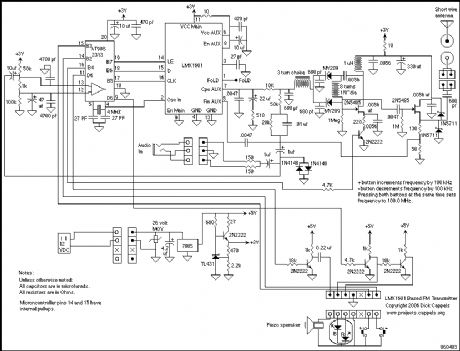
Here's a PLL FM Transmitter using LMX1601, ATtiny2313 or AT90S2313 microcontrollers. The common characteristic of all of the previous low power FM transmitters I've built over the decades, is that their operating frequency is determined by an LC resonant circuit. Some of them had excellent stability, some of them didn't, but I had always wanted to make one that is crystal controlled. Various schemes had been considered from time-to-time, including the direct approach of modulating the load capacitance of a a crystal oscillator, a whimsical phase modulation scheme involving a phase shifter, some balanced modulators, and limiting amplifiers, and at times, the down-to-earth and sober approach of modulating a VCO within a phase locked loop (PLL). While browsing Digikey's online catalog, I found the LMX1601 frequency synthesizer chip and thought: Just maybe, the PLL approach is finally within my grasp. The LMX1601, which apparently was designed for use in cell phones, includes everything need to make two phase locked loops except for the VCOs. More importantly, one of the PLLs, specifically the AUX PLL, is specified to work in the FM broadcast band. The LMX1600 and the LMX1602 were also considered, but the LMX1601 was selected because it has a 500 MHz option , meaning that it can work down to about 50 MHz.
An LMX1601 Phase locked loop, a discreet FET VCO, and an AVR micro controller combine to make a stable, easy to use monophonic FM transmitter that includes a an audio activated switch that turns the transmitter on only when its being used. With the LED lit blue to indicate the transmit mode, the transmitter's user interface is clean and simple. Two push buttons step the frequency up and down. The transmitter comes one when audio of sufficient amplitude is applied, and stays on for five minutes after the audio drops below the threshold. The LED flashes red briefly to show when audio is detected, so I know if the volume of the audio signal is high enough. A small hole under the LED is for the piezoelectric transducer, whose main job is to produce key clicks when the frequency increment and decrement buttons are pressed. The buttons do not provide tactile feedback. The painful part was dealing with the packaging of the chip. The lead centers of this 16 pin package are only 0.65 mm apart. Dealing with the fine printed circuit board features that would be needed to mount this chip was the most daunting aspect of using the chip. I had only experimented with the laser printer toner etch resist method of making PC boards a few months earlier, with some success. As it turned out, the laser printer toner etch resist method could be pushed to make a board that supports this chip. But just barely. (View)
View full Circuit Diagram | Comments | Reading(2899)
PLL FM Transmitters
Published:2012/11/15 0:31:00 Author:muriel | Keyword: PLL, FM , Transmitters
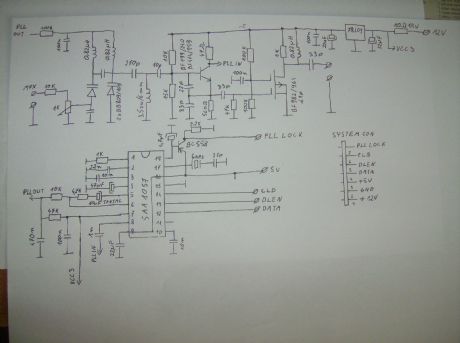
This is PLL FM Transmitter using SAA1057 chip. Transmitter can be operated from a PC through LPT port, or using a PC software as a driver. (View)
View full Circuit Diagram | Comments | Reading(2851)
PLL Exciter-2
Published:2012/11/15 0:30:00 Author:muriel | Keyword: PLL Exciter
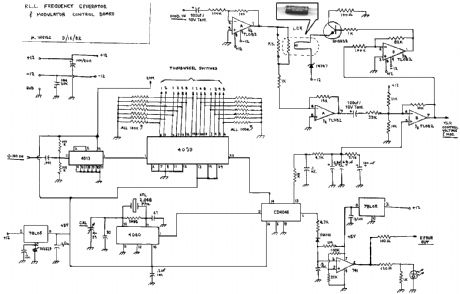
This is a PLL controller that works with the VCO/Modulator that I designed. Use these two modules together for a complete baseband-capable exciter unit. This PLL controller features a rock-stable crystal controlled reference, in conjunction with a programmable dividing network which allows the transmitter to be tuned in 100Khz steps from 79.9Mhz to 109.7Mhz by means of digital thumbwheel switches.
(View)
View full Circuit Diagram | Comments | Reading(2830)
PLL Exciter
Published:2012/11/15 0:29:00 Author:muriel | Keyword: PLL Exciter
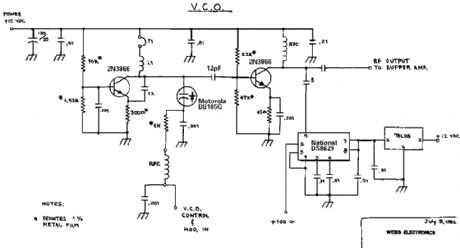
This is a PLL controller that works with the VCO/Modulator that I designed. Use these two modules together for a complete baseband-capable exciter unit. This PLL controller features a rock-stable crystal controlled reference, in conjunction with a programmable dividing network which allows the transmitter to be tuned in 100Khz steps from 79.9Mhz to 109.7Mhz by means of digital thumbwheel switches. (View)
View full Circuit Diagram | Comments | Reading(1071)
Phone Spy Transmitter
Published:2012/11/15 0:29:00 Author:muriel | Keyword: Phone, Spy, Transmitter
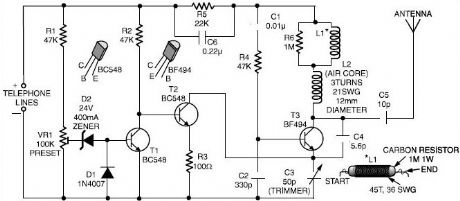
Here is a very simple telephone broadcaster transmitter which can be used to eavesdrop on a telephone conversation. The circuit can also be used as a wireless telephone amplifier. One important feature of this phone transmitter is that the circuit derives its power directly from the active telephone lines, and thus avoids use of any external battery or other power supplies.
This not only saves a lot of space but also money. It consumes very low current from telephone lines without disturbing its performance. The phone bug transmitter is very tiny and can be built using a single -IC type veroboard that can be easily fitted inside a telephone connectin box of 3.75cm x 5cm. The spy phone transmitter consists of two sections, namely, automatic switching section and FM transmitter section. Spy phone transmitter circuit diagram Phone Spy Transmitter Automatic switching section comprises resistors R1 to R3, preset VR1, transistor T1 and T2, zener D2 and diode D1. Resistor R1, along with preset VR1, works as a voltage divider. When voltage across the telephone lines is 48V DC, the voltage available at wiper of preset VR1 ranges from 0 to 32V (adjustable). The switching voltage of the circuit depends on zener breakdown voltage and switching voltage of the transistor T1. Thus, if we adjust preset VR1 to get over 24.7 volts, it will cause the zener to breakdown and transistor T1 to conduc. As a result collector of transistor T1 will get pulled towards negative supply, to cut off transistor T2. At this stage, if you lift the handset of the telephone, the line voltage drops to about 11V and transistor T1 is cut off. As a result, T2 gets forward biased through R2 to provide a DC path for T3 used in the following FM transmitter section. The low-power FM transmitter section comprises oscillator transistor T3, coil L1 and a few other components. T3 works as a common-emitter RF oscillator, with T2 serving as an electronic 搊n/off� switch. The audio signal available across the telephone lines automatically modulates oscillator frequency via T2 along with its biasing R3. The modulated RF signal is fed to the antenna. The telephne conversation can be heard on an FM receiver remotely when it is tuned to the transmitter frequency. (View)
View full Circuit Diagram | Comments | Reading(1123)
Miniature FM Transmitter
Published:2012/11/15 0:28:00 Author:muriel | Keyword: Miniature, FM , Transmitter
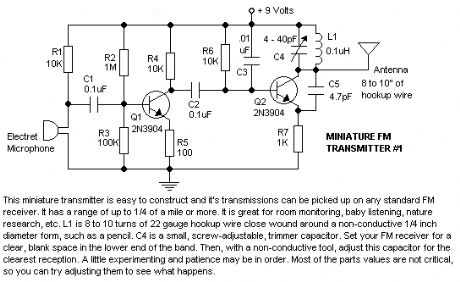
This miniature transmitter is easy to construct and it's transmissions can be picked up on any standard FM receiver. It has a range of up to 1/4 of a mile or more. It is great for room monitoring, baby listening, nature research, etc. L1 is 8 to 10 turns of 22 gauge hookup wire close wound around a non-conductive 1/4 inch diameter form, such as a pencil. C4 is a small, screw-adjustable, trimmer capacitor. Set your FM receiver for a clear, blank space in the lower end of the band. Then, with a non-conductive tool, adjust this capacitor for the clearest reception. A little experimenting and patience may be in order. Most of the parts' values are not critical, so you can try adjusting them to see what happens.
FM Transmitter Parts: R1, R4, R6 10K resistor R2 1Meg resistor R3 100K resistor R5 100 ohm resistor R7 1K resistor C1, C2 0.1uf capacitor C3 0.01uf capacitor C4 4-40pf variable capacitor C5 4.7pf capacitor Q1, Q2 2N3904 transistor L1 8-10 turns of 22gauge wire around non-conductive 1/4 diameter form Elec Mike Electret Mic (View)
View full Circuit Diagram | Comments | Reading(1705)
Mini FM Transmitter
Published:2012/11/15 0:27:00 Author:muriel | Keyword: Mini , FM , Transmitter
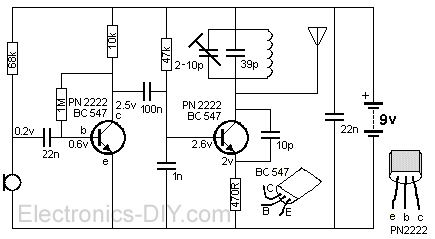
9 Volt battery operated simple Mini FM Transmitter. FM Transmitter is very simple, compact, and has transmission signal with a range of 100-150m, good sensitivity and low current consumption. Transmitter's schematic consists of a bass amplifier for the first transistor and the proper frequency generator in the second. FM Transmitter divided transitional capacitor that allows you to set up a cascade separately.
Transmitter PCB shows the value of all the details and transistors! Reel contains 5 turns enameled wires 0.35mm to send a diameter of 3.2mm (rod of the handle). Setting frequency boils down to the installation shown in the pattern of voltages through appropriate resistors, and then check the current consumption � it should be about 10mA antenna � a piece of wire 40cm. Here you can see the bug assembly factory performance. FM Transmitter uses very small PCB and some SMD resistors.
(View)
View full Circuit Diagram | Comments | Reading(3262)
| Pages:273/2234 At 20261262263264265266267268269270271272273274275276277278279280Under 20 |
Circuit Categories
power supply circuit
Amplifier Circuit
Basic Circuit
LED and Light Circuit
Sensor Circuit
Signal Processing
Electrical Equipment Circuit
Control Circuit
Remote Control Circuit
A/D-D/A Converter Circuit
Audio Circuit
Measuring and Test Circuit
Communication Circuit
Computer-Related Circuit
555 Circuit
Automotive Circuit
Repairing Circuit
